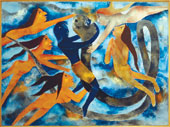 |
| Political grimace: A painting by Bijon Chowdhury |
Any time is art time in Calcutta. Yet, because there undoubtedly is an air of celebration in the crisp air and limpid light of November, Samokal Gallery, located above Mouchak in Golpark, pays a tribute to the spirit of the season ? the season of mists on the one hand and of religio-social festivities on the other ? with a special show Utsav, 2005, which presents, till November 14, works by 31 artists.
What’s special here isn’t so much the theme of the show ? which most artists haven’t really abided by ? but the organisers’ commitment to tradition. And so you have two sections -- one to savour period flavour, the other to trek with time.
The first section first. The ancient period of modern Indian art began, as everyone knows, with the Bengal School and that, roughly, is the style statement of this section. There are three delicately executed paintings by Satyendranath Bandopadhyay that bear the unmistakable imprint of the masters, Abanindranath and Nandalal. Indeed, so representative of the genre are these works that their different sources and elements can be clearly indicated as in a lesson.
More Bengal School comes from Dilip Banerjee and Ajoy Kumar Banerjee. Ratan Acharya, on the other hand, leans towards a rather stilted, academic approach. Siddhartha Sengupta is more thoughtful in depicting a middle-aged Krishna, whose upraised right hand and pointer are ready to receive the chakra. His other painting, on Krishna as a cowherd, is small but noticeable for its sketchy lines, spare strokes and abundance of eloquent white space. Equally engaging is Ramanando Bandopadhyay, one of whose works underlines the spirit of the theme by stressing communal amity.
In the other section, it is Isha Muhammad who holds viewer attention with three paintings, small in size though they are. This is because of their geometric ordering of space into rugged, weathered blocks and beams of thick paint muffling echoes of form. Another work to linger on is Bijon Chowdhury’s dramatic sketch of a charging bull felling people. Which seems to suggest a political grimace since a cloak of red surrounding the beast has tridents drawn on it along with the words ‘Ram’ and ‘Om’. Intended as a satiric footnote to the festivities, perhaps.
If Ritu Singh finds in Mother Teresa an icon to recall in a season when spending goes reckless regardless of the grim reminders of everyday reality all around, more in tune with the mood of Utsav is Mihir Mitra whose quaintly decorative images ? goddess Durga and her lion ? reduce solemn ritual to whimsical playacting.
While B.R. Panesar’s landscapes evoke, as usual, an expansive sweep of space and a hint of motion, what appeals to the viewer in Shanu Lahiri’s work with its swift lines and incipient imagery is its light-hearted brio. And Prakash Karmakar still stands out for the brevity of his drawing.
Samir Roy remains sombre in the grotesque distortion of a man’s head which suffers from lack of vigour. The urban temperament of Sadhan Chakraborty is reflected in the sharply-outlined silhouette of a human profile. But to Shibani Sengupta, however, it seems that the season turns meaningful only in nature as she dwells with sensuous care on clusters of leaves that, lit by a gentle light, merge into the inflected greens of the background shadows.

